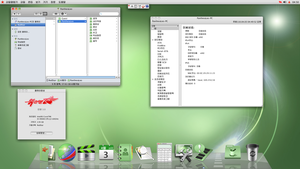 | |
 Screenshot of the desktop of Red Star OS 3.0, localized with North Korean terminology and spelling | |
| Developer | Korea Computer Center, North Korea |
|---|---|
| OS family | Linux (desktop and server), Android (on Woolim, Arirang, Samjiyon, Manbang, Jindallae and Ryonghung)[1][2][3] |
| Working state | Current |
| Source model |
|
| Latest release | 4.0 |
| Marketing target | Personal computers |
| Available in | Korean |
| Platforms | IA-32, x86-64 (server only), ARM (mobile and tablet only) |
| Kernel type | Monolithic forked from (Linux kernel) |
| Influenced by | Fedora Linux (desktop), CentOS (Server), Android (mobile and tablet)[4] |
| Default user interface | KDE[5] |
| License | GPL (Linux kernel and other GNU software only), Proprietary |
Preview warning: Page using Template:Infobox OS with unknown parameter "date"
Red Star OS (Korean: 붉은별; MR: Pulgŭnbyŏl) is a North Korean Linux distribution, with development first starting in 1998 at the Korea Computer Center (KCC). Prior to its release, computers in North Korea typically used Red Hat Linux,[6] and later switched to modified versions of Microsoft Windows with North Korean language packs installed. [7]
Version 3.0 was released in the summer of 2013, but as of 2014[update], version 1.0 continues to be more widely used.[verification needed] It is only available in Korean, localized with North Korean terminology and spelling.[8], although it is possible to change it to English by modifying the ISO file or on the BIOS boot menu[9].
- ^ "Domestic Tablet". NK News. Retrieved 2022-07-07.
- ^ "Domestic Tablet". NK News. Retrieved 2022-07-07.
- ^ "North Korean Smartphone". Mashable. Retrieved 2022-07-07.
- ^ "Inside North Korea's Totalitarian Operating System". Motherboard. 27 December 2015. Retrieved 2017-08-31.
- ^ "Red Star OS". ArchiveOS. Retrieved 2017-08-31.
- ^ Kim, Chi-yong (2006-06-21), "〈민족정보산업의 부흥 -상-〉 《우리식 콤퓨터조작체계(OS) 》의 개발과 도입", Choson Sinbo (in Korean), archived from the original on 2007-12-23
- ^ "North Korea's 'paranoid' computer operating system revealed". The Guardian. 27 December 2015. Retrieved 4 May 2018.
- ^ Nam, Hyeon-ho (2010-03-03), 北, 독자적 컴퓨터 운영체제 '붉은별' 개발, Yonhap News (in Korean), retrieved 2013-01-23
- ^ "Notes on Red Star OS 3.0". messaroundery.net. 2015-01-01. Retrieved 2024-10-29.